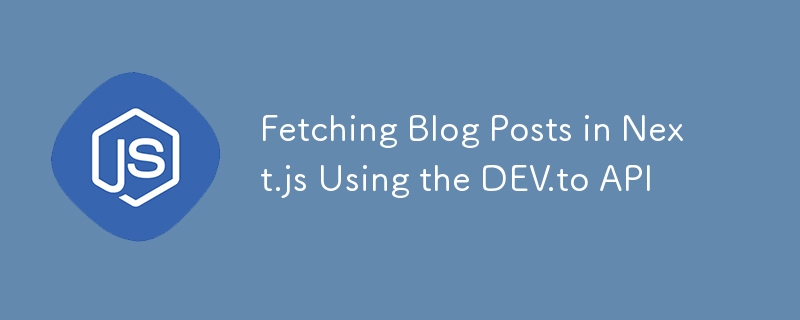使用 DEV.to API 在 Next.js 中取得部落格文章
- 王林原創
- 2024-09-07 06:43:13960瀏覽

如果您想在 Next.js 網站上展示您的 DEV.to 部落格文章,那麼您很幸運! DEV.to 提供了一個易於使用的 API,可讓您以程式設計方式取得部落格文章。在本指南中,我將向您展示如何將 DEV.to 的 API 整合到您的 Next.js 應用程式中並動態顯示您的部落格內容。
讓我們開始吧!
1. 設定 Next.js 項目
首先,如果您還沒有設定一個新的 Next.js 項目,請執行:
npx create-next-app@latest my-dev-blog cd my-dev-blog
現在我們已經準備好了 Next.js 應用程序,讓我們繼續獲取我們的部落格文章。
2. 從 DEV.to API 取得部落格文章
DEV.to API 透過簡單的 HTTP 請求提供對您發佈的文章的存取。您可以點選端點來按使用者取得文章:
https://dev.to/api/articles?username=yourusername
為了取得 Next.js 應用程式中的部落格文章,我們將使用 SWR 函式庫。 SWR 是一個流行的資料獲取庫,旨在讓您在 React/Next.js 應用程式中輕鬆取得、快取和更新資料。
安裝 SWR:
npm install swr
現在,讓我們建立一個實用函數來處理 API 請求:
// src/lib/fetcher.ts
export default async function fetcher(url: string) {
const response = await fetch(url);
if (!response.ok) {
throw new Error("Failed to fetch data");
}
return response.json();
}
3. 建立部落格頁面
現在我們有了 fetcher 實用程序,讓我們建立一個部落格頁面來顯示您的 DEV.to 貼文。
在pages/blog/index.tsx中,使用SWR取得並顯示部落格文章:
import { Container, Row, Col, Card, Button, Badge } from 'react-bootstrap';
import Head from 'next/head';
import useSWR from 'swr';
import fetcher from '../../lib/fetcher';
import Link from 'next/link';
import { formatDistanceToNow, parseISO } from 'date-fns';
interface BlogPost {
id: number;
title: string;
description: string;
slug: string;
cover_image: string;
tag_list: string[];
reading_time_minutes: number;
published_timestamp: string;
positive_reactions_count: number;
}
const Blog = () => {
const { data, error } = useSWR<BlogPost[]>('https://dev.to/api/articles?username=yourusername', fetcher);
if (error) return <div>Failed to load posts</div>;
if (!data) return <div>Loading...</div>;
return (
<>
<Head>
<title>Blog | Your Name</title>
</Head>
<Container>
<Row>
<Col>
<h1>Blog</h1>
<Row className="g-4">
{data.map((post: BlogPost) => (
<Col md={4} key={post.id}>
<Card className="blog-card" data-aos="fade-up">
<Card.Body>
<Card.Title>{post.title.length > 50 ? `${post.title.substring(0, 50)}...` : post.title}</Card.Title>
<Card.Text>{post.description}</Card.Text>
<div className="mb-2">
{post.tag_list.map((tag: string) => (
<Badge pill bg="secondary" className="me-1" key={tag}>
{tag}
</Badge>
))}
</div>
<div className="text-muted">
<small><i className="fa-solid fa-clock"></i> {post.reading_time_minutes} min read</small><br/>
<small><i className="fa-solid fa-calendar-day"></i> {formatDistanceToNow(parseISO(post.published_timestamp), { addSuffix: true })}</small><br/>
<small><i className="fa-solid fa-thumbs-up"></i> {post.positive_reactions_count} Likes</small>
</div>
<Link href={`/blog/${post.slug}`} passHref>
<Button variant="outline-primary" className="mt-3">Read More</Button>
</Link>
</Card.Body>
</Card>
</Col>
))}
</Row>
</Col>
</Row>
</Container>
</>
);
};
export default Blog;
4. 新增動態部落格頁面
Next.js 提供動態路由,讓您為每個部落格文章產生單獨的頁面。讓我們建立一個動態路由來顯示每個貼文。
建立一個名為pages/blog/[slug].tsx的檔案:
import { useRouter } from 'next/router';
import useSWR from 'swr';
import { Container, Row, Col, Card, Button } from 'react-bootstrap';
import Head from 'next/head';
import Image from "next/image";
import fetcher from '../../lib/fetcher';
const BlogPost = () => {
const router = useRouter();
const { slug } = router.query;
const { data, error } = useSWR(slug ? `https://dev.to/api/articles/yourusername/${slug}` : null, fetcher);
if (error) return <div>Failed to load the post</div>;
if (!data) return <div>Loading...</div>;
return (
<>
<Head>
<title>{data.title} | Your Name</title>
</Head>
<Container>
<Row>
<Col>
<div className="section-title">
<h1>{data.title}</h1>
<p>{data.readable_publish_date}</p>
</div>
<section>
{data.cover_image && (
<Image
src={data.cover_image}
alt={data.title}
className="img-fluid mb-3"
width={1000}
height={420}
layout="responsive"
/>
)}
<div dangerouslySetInnerHTML={{ __html: data.body_html }} />
</section>
<Button variant="outline-dark" href="/blog">
Back to Blog
</Button>
</Col>
</Row>
</Container>
</>
);
};
export default BlogPost;
此頁面使用 URL 中的 slug 取得各個帖子,並使用angerouslySetInnerHTML 安全地使用 HTML 內容呈現它們。
5. 最後的潤飾
您現在可以透過執行以下命令啟動 Next.js 應用程式:
npm run dev
造訪 /blog 路線,您應該會看到顯示您的 DEV.to 部落格文章。點擊任何貼文都會將您帶到單一部落格貼文頁面。
- 結論 在本教程中,我們學習如何在 Next.js 應用程式中從 DEV.to API 取得和顯示部落格文章。這是將您的 DEV.to 內容整合到您的個人網站中的強大方法,同時利用靜態網站生成和客戶端渲染的優勢。
您可以隨意進一步自訂此設定、新增分頁或改進樣式以符合您網站的設計!
如果您有任何問題或建議,請在評論中告訴我。
以上是使用 DEV.to API 在 Next.js 中取得部落格文章的詳細內容。更多資訊請關注PHP中文網其他相關文章!

